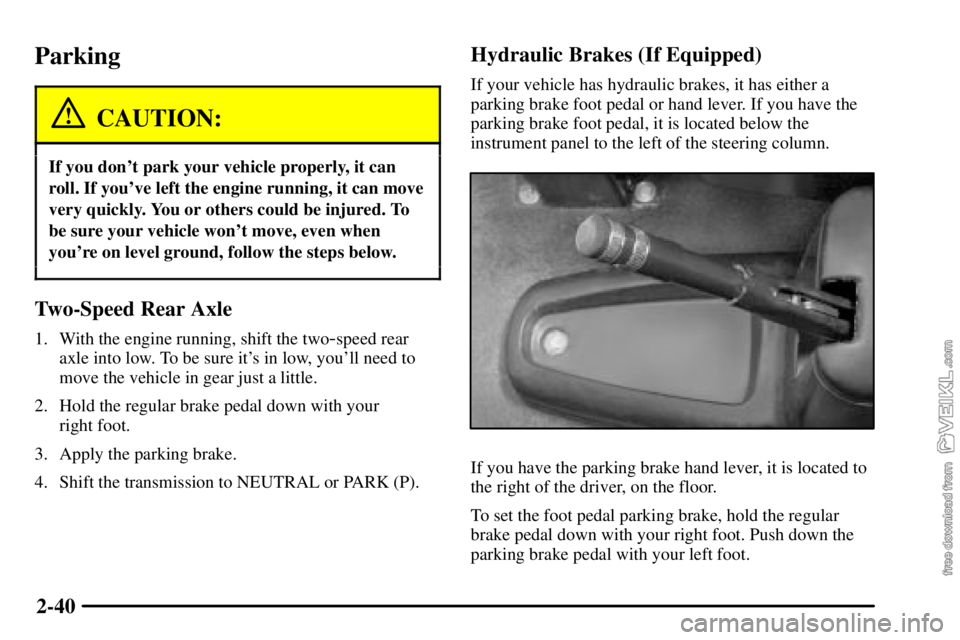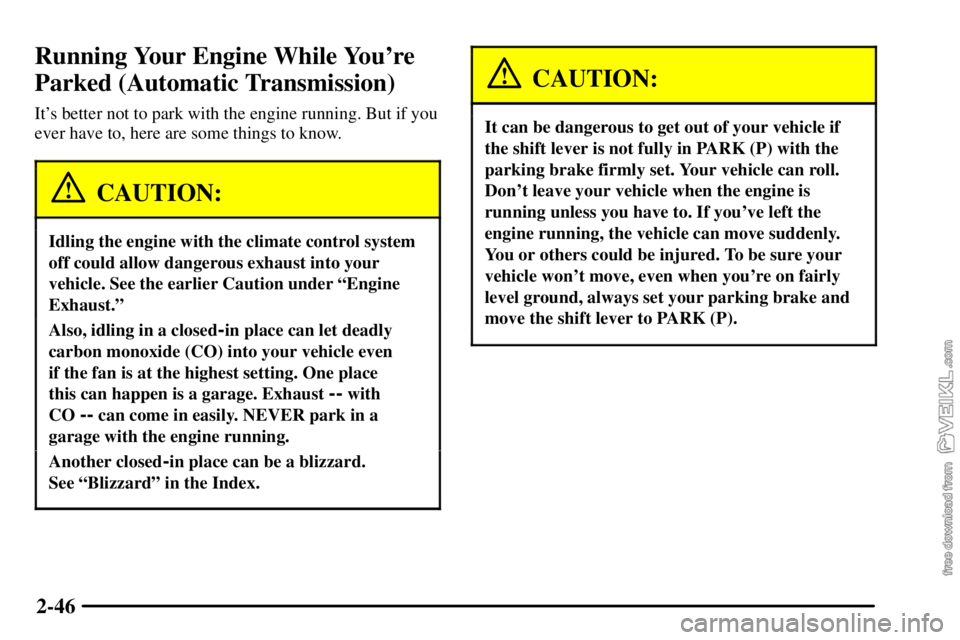Page 114 of 386

2-39 Eaton Fuller Nine and Ten-Speed
Non-Synchronized Manual Transmissions
(If Equipped)
If your vehicle has one of these unsynchronized
transmissions, it's naturally somewhat complicated.
The label above the windshield will tell you the
operating basics you need to know.
The following are driving tips.
�Always choose an initial starting gear suitable for
the load and terrain.
�Always use double
-clutching procedures
when shifting.
�Never move the range shift lever to the LO speed
gear position after HI range preselection, or anytime
the transmission is in the HI range.
�Never move the range knob or lever with the shift
lever in NEUTRAL while the vehicle is moving.
�Never make a range shift while moving
in REVERSE (R).
Clutch Brake (Vehicles with
Non-Synchronized Transmission)
A clutch brake is used to stop transmission input shaft
rotation so that FIRST (1) or REVERSE (R) gear
selection can be initiated when the vehicle is at a
standstill and the engine is idling.
Press the clutch pedal all the way down to the
floorboard to apply the clutch brake.
When using the clutch brake, disengage the clutch pedal
and shift the transmission into either the initial starting
gear or REVERSE (R). If the tooth
-butting occurs
between the clutching teeth, re
-engage the clutch while
applying light pressure to the shift lever. This will
provide for a smooth shift into either FIRST (1) or
REVERSE (R) gear.
NOTICE:
After engaging FIRST (1) or REVERSE (R) gear,
do not use the clutch brake for upshifting and
downshifting. To do so will shorten the service life
of the clutch brake and gear selection shift efforts
may be increased.
Page 115 of 386

2-40
Parking
CAUTION:
If you don't park your vehicle properly, it can
roll. If you've left the engine running, it can move
very quickly. You or others could be injured. To
be sure your vehicle won't move, even when
you're on level ground, follow the steps below.
Two-Speed Rear Axle
1. With the engine running, shift the two-speed rear
axle into low. To be sure it's in low, you'll need to
move the vehicle in gear just a little.
2. Hold the regular brake pedal down with your
right foot.
3. Apply the parking brake.
4. Shift the transmission to NEUTRAL or PARK (P).
Hydraulic Brakes (If Equipped)
If your vehicle has hydraulic brakes, it has either a
parking brake foot pedal or hand lever. If you have the
parking brake foot pedal, it is located below the
instrument panel to the left of the steering column.
If you have the parking brake hand lever, it is located to
the right of the driver, on the floor.
To set the foot pedal parking brake, hold the regular
brake pedal down with your right foot. Push down the
parking brake pedal with your left foot.
Page 119 of 386

2-44
CAUTION:
If you apply any one of the air brake parking
controls while the vehicle is moving, your rig will
stop suddenly. If you are not ready for this, you
or others could be injured. Don't apply any one
of these controls while you're driving, unless you
have to make an emergency stop.
If the air pressure drops below 60 to 70 psi (413 to
482 kPa), the primary brake light and warning buzzer
will come on. If the air pressure drops to 35 to 45 psi
(241 to 310 kPa), the red trailer air supply knob will
automatically pop out and apply the spring brakes on
the trailer.If the air pressure drops to 35 to 45 psi (241 to 310 kPa),
the yellow park brake knob will automatically pop out
and apply the spring brakes on the truck or tractor.
If you ever have a complete loss of air so that your air
brakes automatically apply, there is a way that the tow
operator can release the parking brakes to tow the
vehicle. See ªTowing Your Vehicleº in the Index.
CAUTION:
If your vehicle is left in gear, the engine can start
if the vehicle starts to roll. This can easily happen
if you have the diesel engine. Shift the
transmission into NEUTRAL (N) before you
leave the vehicle.
Page 120 of 386
2-45
Parking Over Things That Burn
CAUTION:
Things that can burn could touch hot exhaust
parts under your vehicle and ignite. Don't park
over papers, leaves, dry grass or other things that
can burn.
Engine Exhaust
CAUTION:
Engine exhaust can kill. It contains the gas
carbon monoxide (CO), which you can't see or
smell. It can cause unconsciousness and death.
You might have exhaust coming in if:
�Your exhaust system sounds strange or
different.
�Your vehicle gets rusty underneath.
�Your vehicle was damaged in a collision.
�Your vehicle was damaged when driving over
high points on the road or over road debris.
�Repairs weren't done correctly.
�Your vehicle or exhaust system had been
modified improperly.
If you ever suspect exhaust is coming into your
vehicle:
�Drive it only with all the windows down to
blow out any CO; and
�Have your vehicle fixed immediately.
Page 121 of 386

2-46
Running Your Engine While You're
Parked (Automatic Transmission)
It's better not to park with the engine running. But if you
ever have to, here are some things to know.
CAUTION:
Idling the engine with the climate control system
off could allow dangerous exhaust into your
vehicle. See the earlier Caution under ªEngine
Exhaust.º
Also, idling in a closed-in place can let deadly
carbon monoxide (CO) into your vehicle even
if the fan is at the highest setting. One place
this can happen is a garage. Exhaust
-- with
CO
-- can come in easily. NEVER park in a
garage with the engine running.
Another closed-in place can be a blizzard.
See ªBlizzardº in the Index.
CAUTION:
It can be dangerous to get out of your vehicle if
the shift lever is not fully in PARK (P) with the
parking brake firmly set. Your vehicle can roll.
Don't leave your vehicle when the engine is
running unless you have to. If you've left the
engine running, the vehicle can move suddenly.
You or others could be injured. To be sure your
vehicle won't move, even when you're on fairly
level ground, always set your parking brake and
move the shift lever to PARK (P).
Page 122 of 386
2-47
CAUTION:
It can be dangerous to get out of your vehicle
without the parking brake firmly set. Your
vehicle can roll. If you've left the engine running,
the vehicle can move suddenly. You or others
could be injured. To be sure your vehicle won't
move, even when you're on fairly level ground,
always set your parking brake.
Follow the proper steps to be sure your vehicle
won't move.
Horn
Sound the horn by pushing the center of the steering
wheel. If you have the optional air horn, it is controlled
by a cord that you'll find up above and to the left of
the driver. The harder you pull on the cord, the louder
the air horn will sound. The air horn works only after
your air brake system pressure gets up to about
115 psi (790 kPa). The air horn will work properly
unless the the air brake system pressure drops
below 60 psi (415 kPa).
Page 145 of 386
2-70
Instrument Panel Cluster
Your instrument panel cluster is designed to let you know at a glance how your vehicle is running. You'll know how
fast your going, about how much fuel is left and many other things you'll need to drive safely and economically.
United States, Diesel Engine shown, Canada and Gasoline Engine similar
Page 146 of 386
2-71 Speedometer and Odometer
Your speedometer lets you see your speed in both miles
per hour (mph) and kilometers per hour (km/h).
Your odometer shows how far your vehicle has been
driven, in either miles (used in the United States) or
kilometers (used in Canada).Trip Odometer
The trip odometer can tell you how far your vehicle has
been driven since you last set the trip odometer to zero.
While the engine is running, press the reset button,
located to the right of the trip odometer, to toggle
between the trip odometer and the regular odometer.
Holding the reset button for two seconds while the
engine is running and the trip odometer is displayed,
will reset it.
To display the odometer reading with the ignition off,
press the reset button.